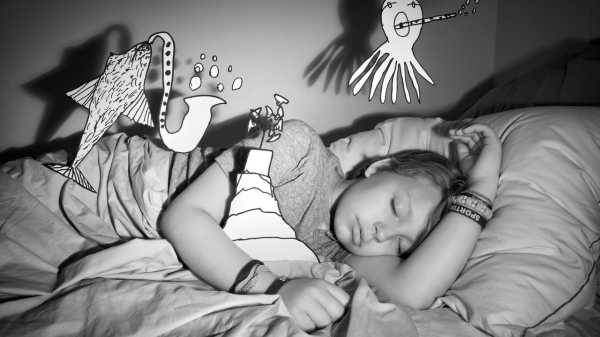
Save this storySave this storySave this storySave this story
“Nothing describes children’s drawing in general better than the term realism,” Georges-Henri Luquet wrote in his classic study, “Le Dessin Enfantin” (“Children’s Drawings”), from 1927. Fourteen years earlier, Luquet—who also wrote about topics such as medieval history, logic, and philosophy—had put together a monograph on the more than fifteen hundred drawings made by his daughter, “Les Dessins d’un Enfant” (“A Child’s Drawings”). This was a man who took the drawings of children seriously. He argued that kids often draw what they know, rather than what they see, and that their drawings incline more to internal understandings than to external observations.
The kids in Bela Borsodi’s photograph series “Lucid Dreamers” also seem to be realists. In the text that accompanies each image, they describe their drawings as if each item or creature exists beyond their imagination: it is something that the child has found as much as made. One child, Zoie, specifies that the harness on her dragon was constructed from fabric torn by its claws. A penguin is singing, but not very well, so Zoie steers her dragon away.

Zoie is riding a fire-breathing dragon. “I made the harness out of a blanket which I ripped by using the dragon’s claws. The dragon is running towards a huge penguin who has a dragon tail and sits on a giant rock. I’m trying to change direction because the penguin is singing an annoying song.”
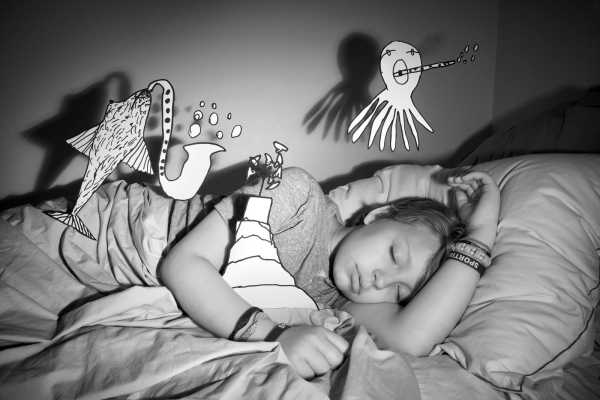
Lou has a good sense of humor. “I wanted to imagine a funny underwater world. There’s lots of music there. A shark is on the saxophone, an octopus plays the flute, and a school of fish sings into a microphone. When they play their instruments there are lots of bubbles.”
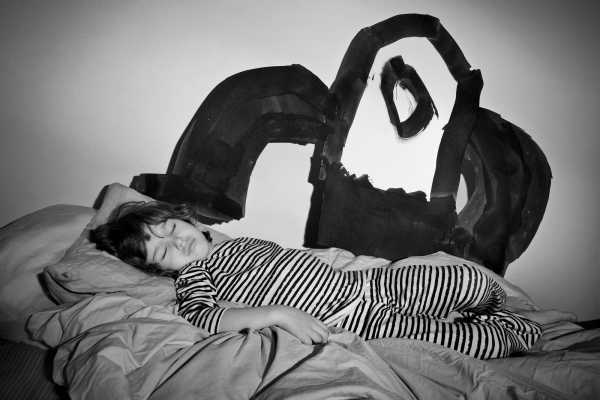
Egon is into mechanical things. “They’re so cool! I drew a rocket cause they’re really fast, and they can push you through gravity. I really like outer space.”
The origin of Borsodi’s series was small scale. A friend, Alice Bertay, asked if he would do an art project for her Web site, kid-in.net, which published photography, design, and art focussed on the subject of childhood. “Her direction was, basically, ‘Come up with something!’ ” he told me. Borsodi is an impish and energetic fifty-eight-year-old. Brought up in Vienna, he now lives in New York. Though he has no children, he is, in his way, childlike. His work includes art for punk-rock records and a cover for the Times Magazine.
Borsodi loved that Bertay’s request was open-ended, but with the constraint that the project needed to be related in some way to children. “So I thought, O.K., what can I do with kids? And, of course, two million ideas go through my head.” Some he liked; some he didn’t. The idea that every adult was once a kid, and maybe still is a kid, was an opening for him. He thought about how, when he was a kid, what interested him most was drawing, which he used as a way to figure things out. He had liked math and physics for the same reason. Drawing, he told me, is “a way to make sense of reality. And drawing has immediacy: it’s direct from the brain to the hand.” Almost all kids love to draw.
Even as a kid, Borsodi found dreams and nightmares compelling. He decided to ask children to draw their dreams and then photograph them amid their drawn dream world. “The first bummer for the kids was that I demanded that, whatever it is that we do here, it has to be black-and-white,” he said, noting that many children’s favorite color is “rainbow.” But he brought in all sorts of paints and ink and pencils and Sharpies—many different kinds of black—and told the kids not to worry about being messy.
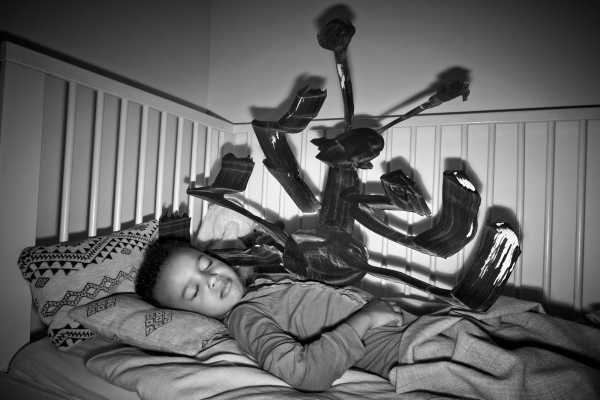
Jules is an animal lover, and is interested in studying them. “Ants are really amazing creatures. They’re my favorite insect, but porcupines are my favorite animal overall.”

Theo likes figures and equations. “This is a futuristic ship in 2033 that shoots numbers as bullets. These numbers add up and then the ship decides how many bullets to shoot to resolve problems.”
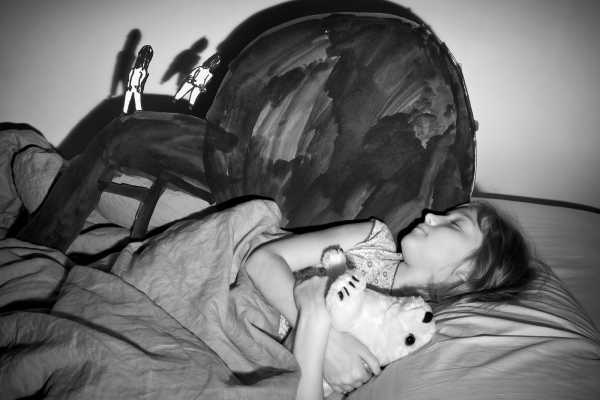
Gloria thought of something crazy. “A big black blob of jello and hungry people who want to eat it. There is a diving board that they are about to jump into the blob and get stuck. They all have hair like me.”
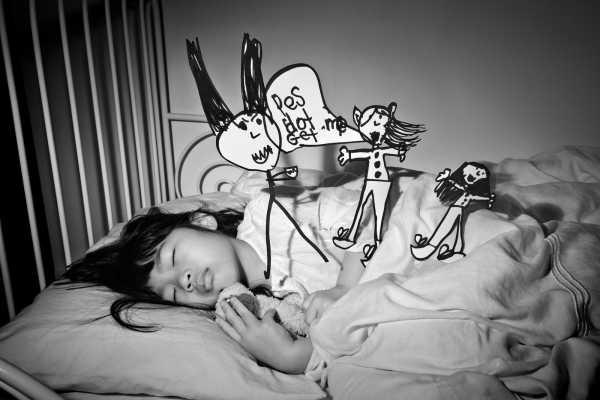
Sabine doesn’t know why there was a naked, evil girl in her dream who wanted to kill her mother. “She tried to give my mom a poisonous magic potion, and my mom screamed: ‘Please don’t get me.’ I was worried and stood next to her as it happened. My mom was wearing the same T-shirts, pants, and shoes as me.”
Borsodi admits almost bashfully that he’s good with kids. “I don’t come at them with this adult stuff—I see them as on a level with me,” he explained. “And, when I was a kid, I saw myself as a small adult.” But tasking kids with drawing their dreams proved to be less than straightforward. Some responded to the idea; others did not. They wanted to show what they could do, “so they often started with a cartoon character they knew,” he said.
The young artists included the children of friends, and then of the friends of friends, and, “finally, of the friends of friends of friends,” he said. They ranged in age from about five to twelve. The kids arrived at the drawings in these photos each in their own way. Egon, for instance, was keen to participate, but he was resistant to receiving direction—he wasn’t going to draw anything on request. “He would fill up a white sheet of paper with black from edge to edge. One after another,” Borsodi recalled. “Finally, I forget exactly what he said, but something like ‘That’s how the world is.’ So he actually had, really, a voice of a mature artist! Almost a Malevich or something.” Borsodi considered photographing Egon with one of the black squares. “But I had to also consider the other kids, and the whole project,” he said. Ultimately, he felt that he needed something from Egon that was “a little bit more figurative.” Meanwhile, Egon’s mother had a drawer full of Egon’s art, much of it depicting rockets. Would Egon paint a rocket for him? Borsodi asked. Egon said no, he wouldn’t. But later, unprompted, he drew one.
Gloria wanted to paint rainbows. The black-and-white limitation frustrated her. She drew a series of rainbows in black-and-white, but she wasn’t pleased with them. Somehow Borsodi reached her by saying, “Well, just imagine something crazy.” That excited her. As she painted, she narrated to Borsodi what she was depicting: a big black blob of jello that hungry people, diving off a diving board, will get stuck in. “And then she said to me, ‘Oh, see, this is crazy because this is what happens in my dreams.’ ”
Then there was Rosa. She wanted to explain to Borsodi what Pom—the creature she had drawn—was like. He was ultra-powerful and could tear people apart, but with Rosa he was always very sweet, and he protected her. He could be nice to others, too, unless they did something mean. And Wim: the youngest of the artists, he quickly made a single drawing, and then was done. He announced that it was a tree in a cage.

This monster is always with Rosa. “Her name is Pom and she’s very sweet. She’s very old, has big claws, and if I’m bored or lonely I can always play with her.”
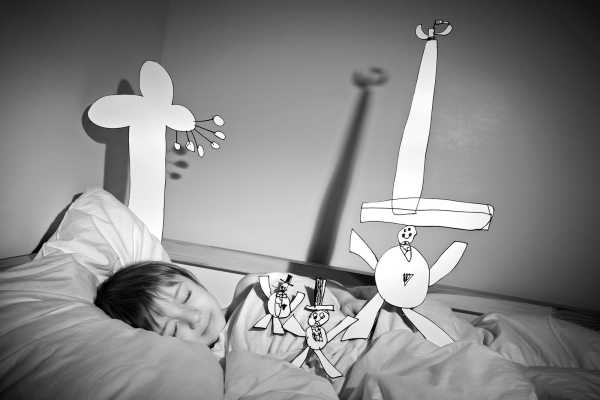
Casper imagines three little children dressed as old men with beards. “They are wearing different-sized hats, and are going for a picnic to the top of a hill. Up there is an apple tree which has six apples on it, two for each of them. Sitting on top of the biggest hat is a large vulture.”

Bea wants to be an actress. “Here I am playing the Queen of Evil after I am discovered acting on the street. I’m wearing a black dress and a crown, and I’m shouting ‘Evil!’ On the left is the guy with the slate, and on the right is my director sitting in his chair.”
Borsodi scanned and enlarged the drawings, mounted them onto cardboard, and then cut out the images as precisely as possible, “following the contours of the drawing or whatever made sense,” he said. He used wire constructions to keep the drawings upright. When he was ready to take the photographs, he wanted them to look as if they had been made with a night-vision camera, like the ones used in documentaries about war or in nature footage following the nocturnal ways of creatures, such as lionesses on a hunt. “I just love this eerie look,” he said. “It catches something.” Borsodi used a red filter on his strobe light to produce the night-vision-camera effect. The children in the photos are only pretending to be asleep. You can see a small smile on Casper, as he feigns slumber near his drawings of what he described as “children dressed as old men.”
Most of the depictions of dreams and visions have mixed emotional valences: the thrill of discovering a creature alongside the terror of that creature eating a surfer who has done the terribly risky thing of falling asleep; the gentle vision of a peace machine, but finding it necessary to arm it with weapons and dead mice; the triumph of finding oneself cast in a starring role—but the starring role is as the queen of evil. Almost as if by sorcery, the photographs appear to capture the children’s evanescent, interior thoughts. This is the emotional realism of the mostly fantastical drawings. It reminds me of the intensity of feeling and wonder behind so many attempts to photograph ghosts, fairies, spirits.
Borsodi told me that one of his favorite children’s-book illustrators and authors is Tomi Ungerer, who died in 2019. Ungerer also designed political posters and ad campaigns for the Village Voice and the Times. Of Ungerer’s books for children, Borsodi observes that “there is always something scratchy and itchy about them. Not everybody is just good and bad. There’s not always a resolution.” When Borsodi was young, he found Ungerer’s work a bit scary, which he said made it irresistible for him. “But since the over-all tone of everything is so fascinating, and actually positive—I mean, even the negative can be positive—he was one of my heroes.”

Dante makes clear that these figures are not real. “They are from my dreams and they’re both happy and sad. They are an even number of each feeling, so both are equal. Everyone should see they have wheels on their feet for movement and one has hair shaped like a baobab tree. I love baobab trees.”
Sourse: newyorker.com
